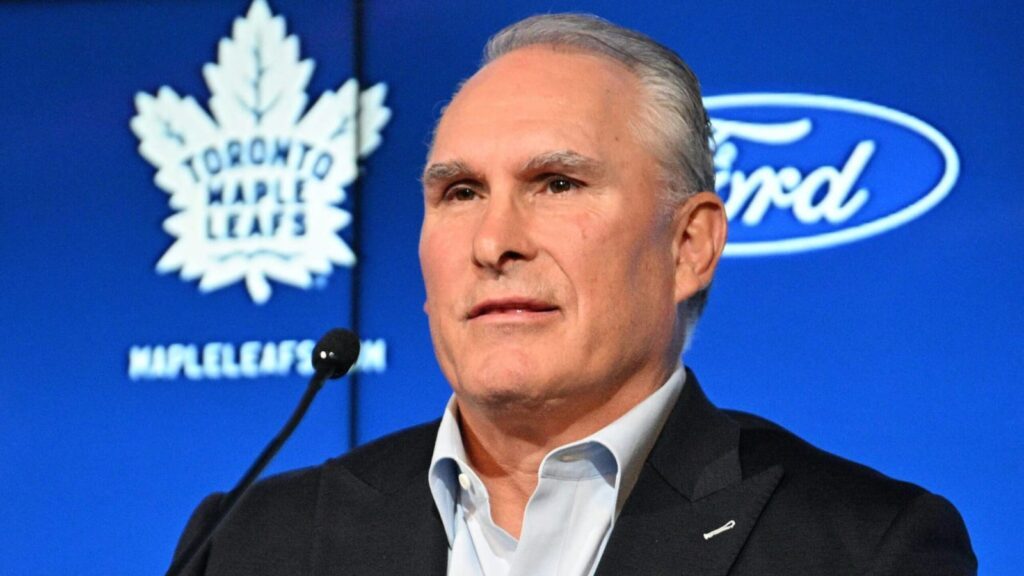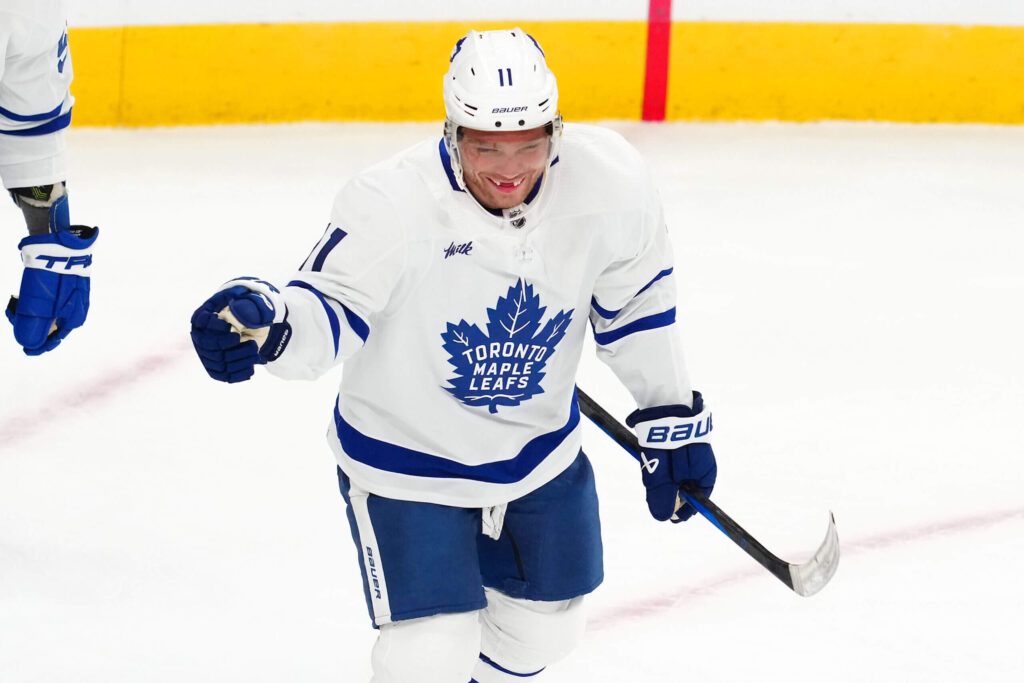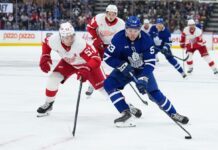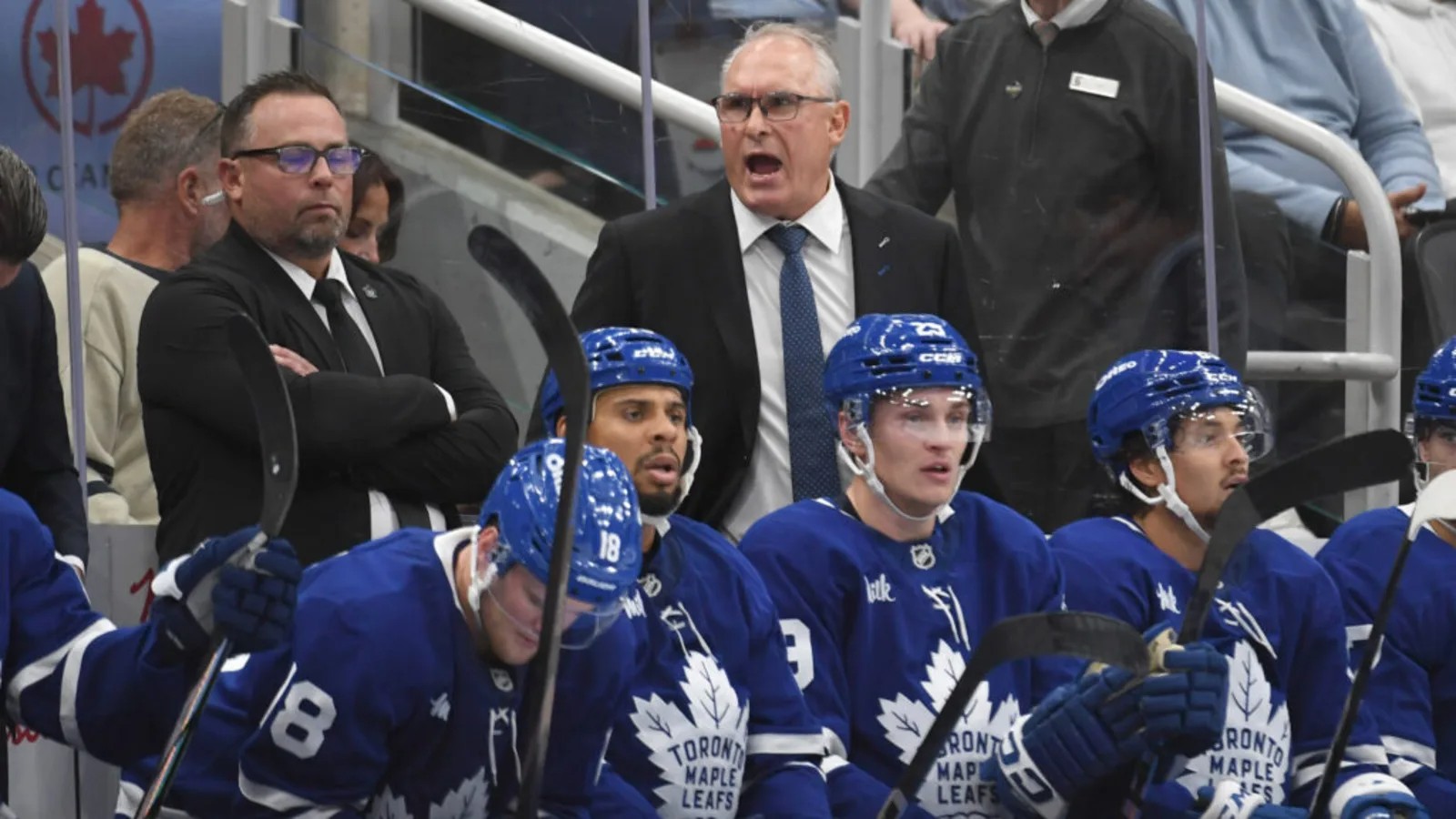The regular season is finally here!
After a long summer of speculation and rumours, the Leafs largely walked back the core of their team, overhauled the coaching staff, and made some moves to address their defense.
The changes on defense are already evident, and the coaching staff is also instilling a simple system that already looks notably different — a lot more chip-and-chase type plays, very little regrouping, and quick ups on the breakout.
There is a long way to go, but noticeable differences are starting to play out, and there is more to come, considering four players who likely consider themselves regular, everyday players have yet to play a game this season.
One is Timothy Liljegren, who is a story in and of himself, given the team has made him a healthy scratch. The other three players are all on LTIR: Connor Dewar, Calle Jarnkrok, and Jani Hakanpaa.
The fact that Dewar started the season on IR and not LTIR indicates to me that there was at least some level of hope he would be back sooner than later, but once Joseph Woll joined him on IR, they needed to create cap space to bring up another goalie.
The Leafs may have a revolving door of injuries and players on LTIR throughout the season to the point where they are never truly forced to make a move, but if/when players get healthy, moves will have to be made. Cap aside, they don’t even have the roster room to activate any player off of LTIR, as they have a maxed-out 23-man roster.
Compounding matters is that if the team remains in LTIR, any trade they could potentially make will have to be money out for money in. The Leafs have very limited draft capital to be aggressive buyers, let alone pay extra for double retention.
This all makes for a more interesting opening month than usual for me. In most years, I start the season thinking, “Let’s see what this group has,” but this year, for maybe the first time since writing about this team, I’m thinking, “The competition is just beginning.”
The Leafs have 15 viable NHL forwards and possibly up to 10 viable NHL defensemen (depending on how you rate Marshall Rifai, Phillipe Myers, and Jani Hakanpaa’s health).
They are going to have to sort this out somehow in a way that accomplishes the following:
- Avoid spending their precious draft capital on bottom-of-the-lineup type of players. Last deadline, they added a fourth-line forward (Connor Dewar) and two defensemen who aren’t really true top-four defensemen (Joel Edmundson and Ilya Lyubushkin), and while each addition helped in their role, the fact that they were even needed was half the problem.
- Clear cap space so they can either activate players and/or acquire new ones
- Add draft stock so they can either draft players or flip those picks for other players who better fit their needs.
- Find the best mix of 12 forwards and six defensemen. I don’t think this is even close to realized yet.
At this point, October is just an extension of training camp. Other than essentially the top six forwards and top four defensemen, any of the other remaining roster spots are up for grabs.
Notes

– The early returns on the revamped defense have been really good. The Leafs have only allowed five goals through three games, and three have come against the penalty kill. They haven’t played any top teams, and it’s way too early to make any conclusions on the group, but through three games, the Leafs lead the league in expected goals percentage and scoring chances for percentage at even strength. While there is no true star on the unit, one thing we noted in the summer is that they have a good mix. There are quality lefties and righties. There is puck movement, and there is jam.
– It has been interesting to see the Leafs manage this group so far. Morgan Rielly has been forced to play big minutes for years because the Leafs have lacked other options, but that is not the case this season. So far, the leading defensemen in time on ice for the Leafs are Oliver Ekman-Larsson (22:07), followed by Jake McCabe (21:57), Morgan Rielly (21:29), and Chris Tanev (19:37). When the Leafs had Jake Muzzin and TJ Brodie on the blue line, they had two defensemen who they could easily play more than Rielly, but this looks like the first time when they actually have three of those options.
– The most surprising deployment on the entire team so far: Conor Timmins averaging a whopping 2:29 per game shorthanded, which is third among all defensemen on the Leafs. He has generally been thought of and deployed as an offensive defenseman because he is skilled, so this switch in roles is notable. In 50 games with the Leafs before this season, Timmins played all of four minutes and eight seconds on the penalty kill. In three games this season, he has already played 7:28.
Both OEL and Rielly are rightfully going to play on the power play. As a defenseman, you have to contribute in either a power play or a penalty-killing role. That is where Timothy Liljegren seems to be stuck – he’s not going to take power play time from the other two, and he’s not a great penalty killer. Even if he’s solid at 5v5 – where he has won his minutes three straight years – he needs to make a special teams contribution.
So far, Timmins has been serviceable on the penalty kill. His 6’3 frame gets in the way, and he has battled hard in front of the net to clear bodies and pucks. Timmins recorded an assist on the first goal of the season with a good shot through traffic – something he is really good at – and if he can provide that offense and be a serviceable penalty killer, he can carve out a role.
– It should also be noted that Timmins has taken two poor penalties so far. He simply hasn’t played much hockey over the years, and you can see it in the details of his game. I am not sold on him yet by any means, but I would be curious to see him play/stay healthy for 20-30 games and see what he looks like after a good run of hockey. The ability is there.
– So far, the Oliver Ekman-Larsson – Jake McCabe pairing is working well. I wasn’t sure if it would be an awkward fit, but McCabe looks far more comfortable in taking a more defensive role this season compared to last when he drove the puck movement alongside Benoit. It helps that OEL has been really good early on, giving the Leafs another much-needed puck mover from the back end. Between OEL, Rielly, and Timmins, there is a player on each pairing capable of making a play/creating a goal.
– Against Pittsburgh, Matthew Knies played a career-high 21:06. His heavy game meshes well with Berube’s preferred forechecking style, and he has done well to create below the goal line and around the net so far. He has 11 shots through three games, after just 115 in 80 games last season. I was worried about his speed taking a hit after he gained 10 pounds, but so far, it looks like 10 pounds of muscle. He is bullying players off the puck and along the walls.
Nobody else in their top six comes close to playing like him, and it’s particularly important when we look at Boston, whose defense consists of a 6’6 player, two 6’5 players, a 6’4 player, a 6’3 player, and their smallest member – Charlie McAvoy – is “just” 6’1 but extremely strong. I’m very mindful of this group and the need to be able to either match muscle with muscle or burn them with their speed.
– Nice finish by Mitch Marner for his first of the season. We have seen him score that exact goal many times (here is an example of an identical shot against Boston last season). While he is a pass-first player, he has a great shot, and it’s important that he actually uses it. Over the past six seasons, his per-82-game goal average is 30 goals per season. It’s a legitimately good goal-scoring rate.
It didn’t get much attention, but Marner also made a really nice stick lift to make sure the pick got through to Knies before he scored against Pittsburgh. His stick work has been really good so far, and he’s now strong on his stick to win those types of battles. He won a few on a New Jersey Devils power play as well.
– Max Pacioretty has been fine so far, but some of the early concerns about him taking away opportunities from other players are already evident. Bobby McMann was a healthy scratch in game one, and at the end of the game, Pacioretty was on with the net empty over players like Knies and Robertson. When Tavares went down, Pacioretty got the first look on the power play over them, too. If he’s taking away chances from those players – plus the fact that there will likely be bonus money applied to next year’s cap from his contract — he needs to be good to justify his spot. It’s not just a nice story on a cheap deal if this is how he’s used.
Quotes
“We don’t want that. Our team has done a good job of that so far. Montreal and Jersey are quick transition teams — fast teams who want to play on the move.
We want to play our game. We don’t want to get into that back-and-forth type of game. We want to have a territorial game. It is going to be important against Pittsburgh to have that territorial, hang onto pucks, be strong on pucks, and take away their transition game. They are very good down low in the offensive at creating offense. We have to get back, get into good coverage, and make sure we are heavy around our net tonight.”
– Craig Berube on the possibility of a run and gun, trade chances game ahead of playing Pittsburgh.
The Leafs have the same record through three games as last season but have gotten there much differently. Not only did they give up way more last season (13 goals vs. five), but Matthews had back-to-back hat tricks to start the season, whereas he’s pointless through three games this season. While the hat tricks were fun, they were about as sustainable as Matthews going pointless, and the results are still the same because they are checking well. It’s not as fun to watch, but the goal is winning, and this is a better brand of hockey suited to the playoff style, provided the team can get their special teams going.
“There’s obviously adjustments. We’ve checked well. We didn’t give up much, and we’re creating chances. And those chances will start to go in as we continue to build more chemistry as the season goes along, get more acclimated to the way we want to play. I think we’re happy with where we’re at right now.”
– Auston Matthews on the adjustments underway
The Leafs are slowing games down by dumping it in more, checking more diligently, and making teams come all the way down the ice and beat all five defenders. The opposition waited for last season’s Leafs to make a mistake. Chances are, the new approach will cost the star players some offense. It’s important to achieve results to maintain the buy-in, and so far, they are doing a good job of it. It’s easy to revert to old habits when you aren’t scoring or winning.
“Mitch is a star. He is a great player. He has had a great summer. He is prepared. Like anything in life — any job you’re in, or you’re going to school and taking a test — when you’re prepared and you are confident, it allows your ability to take over. That is what Mitch is.
I couldn’t be more pleased with him during camp. He has a lot of juice to him. He brings energy to our group. His on-ice play speaks for itself.”
– Brad Treliving on Mitch Marner heading into the season without a contract
Through three games, Marner is averaging 21:52 per night. It would be the second-highest mark of his career. He’s entrenched on the top line, the top power-play unit, and has been used as one of their best penalty killers. Leafs brass has continually repeated that he’s a star player they’re happy with. I don’t think reading the tea leaves here is particularly difficult.
Tweets of the Week
Now that the actual season opening rosters are taking shape, here's a look at the average ages for the current projected 20-man game lineups.
Buffalo – 25.24
Montreal – 26.30
Utah – 26.31
Philadelphia – 26.33
San Jose – 27.26
Anaheim – 27.30
Colorado – 27.37
Columbus – 27.73…— NHL Rosters (@NHL_Rosters) October 8, 2024
It is no surprise that the Leafs are one of the oldest teams in the league—the sixth oldest, to be exact—as this is a team built to win now. They are spending money on older players with a “win now, ask questions later” mentality. They are in a winning window right now – they have been for a few years now – and need to capitalize.
Seems to be a lot of speculation around Liljegren and the Leafs. Toronto likes the depth they have on D. 2 games in so there’s no imminent trade. Possibility? Sure. Nothing more than that at this point. Nothing front burner.
— Darren Dreger (@DarrenDreger) October 11, 2024
I think patience is the right call unless someone steps up and makes a good offer. Chris Tanev and Conor Timmins are both injury-prone, while Jani Hakanpaa’s status is completely up in the air. Those are the three right-handed defensemen ahead of Liljegren on the depth chart right now, and for the purposes of an 82-game season, you can’t feel great about any of them. So, as long as they can afford it, they should wait it out and watch how things develop.
15 years ago, this year… don’t give up on your dreams, kids https://t.co/OTFl1gWHEC pic.twitter.com/7FYJR2cPqb
— Steph Lorentz (@_stephlorentz) October 11, 2024
From a fan’s point of view, this is a really fun story. A local Leafs fan is living his dream and clearly loving every second so far.
Lorentz can fill his role as an energy player and penalty killer when he’s on his game. He started to come on as a penalty killer down the stretch last season and is carrying it over now; he’s happy to fill the role, which is important.
We have seen skilled players disgruntled by limited minutes and opportunity, but he’ll gladly take his 10-11 minutes per night and fill his role. He is clearly running on some adrenaline right now, and I’m curious to see how he settles in as an everyday player once that wears off, but early on, he has been a noticeable difference-maker.
5 Things I Think I’d Do

1. I think the game against Pittsburgh is a good example of what the Leafs like about Max Domi. He was easily able to shift over to center and give them a good game.
The market for centers was really poor this summer unless you think giving Chandler Stephenson seven years and nearly $44 million is a good idea (I do not). He gives them flexibility, and you need that over the grind of an 82-game season. It’s similar to last season when he started on the wing with Tavares and Nylander, but his best play was at center other than the end of the season when he played with Matthews. Of course, his best hockey came alongside one of the best players in the world.
For me, the best way to use Domi is either back with Matthews or centering a lower line. Last season, Domi, Robertson, and Jarnkrok won their minutes, outscoring opponents 12-8. He could easily do the same on a third line with options like Robertson, McMann, and Pacioretty or have him center Marner and spread their three stars across three lines. At this point, he’s an upgrade at center on Holmberg, who is limited due to his inability to shoot.
2. I think I am confused as to why David Kampf started the season as a penalty-killing afterthought. The Leafs have tried to roll a Holmberg-Lorentz tandem followed by a Matthews – Marner tandem. Holmberg got burned in each of the last two games (one was a bad clear, and the other was him spinning to nowhere). Kampf was shifted into a main penalty-killing role from there.
Simply put, Kampf is a better penalty killer than Holmberg at this point, and I don’t think it’s particularly close. I like Holmberg, but they can’t keep trotting him out on the first penalty-killing unit when he’s skating the wrong way for no reason and isn’t bearing down on clearing attempts, resulting in tape-to-tape passes that end up in the Leafs’ net. Kampf is a genuinely good penalty killer and should be used as such.
3. I think I’d healthy scratch Simon Benoit in the next game. Four penalties through three games – and only one was debatable – is unacceptable. I really like Benoit, and I am sure he will settle down, but he hasn’t gotten off to a great start in general. The penalties are only compounding matters.
On the flip side, it also opens up a spot to play Timothy Liljegren for a game. Whether they want to keep or trade him, he will need to get into some games. It would be the first time in a long time that the Leafs dress a defense unit with three lefties and three righties, and I think the next opponent – the LA Kings – is a good one to add a bit more skill and puck movement on the back end against.
4. I think I liked Nick Robertson with William Nylander and would keep the two together for an extended look, with Tavares as their center. This line was effective last season with Tyler Bertuzzi on the left wing, and while Robertson plays a much different game, one commonality is the second-effort plays that keep possessions alive. Robertson has already drawn multiple penalties while driving into dangerous areas, and he also has the ability to finish when given a clean look.
5. Two glaring issues stand out when I look at the Leafs’ power play attempts so far.
The first is the inability to enter the zone cleanly. The drop pass receives a lot of attention for some reason, but it’s rarely the issue (only when they do it without thinking while there is space right in front of them). It’s almost always the play at the blue line where the Leafs are forcing passes to the boards – usually to a flat-footed John Tavares – and even if it is completed, they aren’t making the right read. The defenseman trailing isn’t getting the puck dropped back to him to settle everything down, and if the opponent cheats to said defenseman, they aren’t executing a far-side rim to stretch the zone and buy themselves some time and space.
Once they do set it up, three players (Matthews, Marner, and Nylander) want to play on the half-wall, and there are only two spots. The three of them have aimlessly circled at the top of the zone countless times through three games—creating a whole lot of nothing—and are seemingly unsure of who the shooter should be (it should be Matthews, obviously).
I would work on the drop/far-side rim entry while putting Nylander and Matthews on the half-wall. Both are shooters, with Marner down low as a righty-to-righty option between him and Nylander. From there, the power play would run through Nylander, with Matthews as the triggerman and Marner as the down-low play who occasionally switches spots with Nylander.














![John Gruden after the Leafs prospects’ 4-1 win over Montreal: “[Vyacheslav Peksa] looked really comfortable in the net… We wouldn’t have won without him” John Gruden, head coach of the Toronto Marlies](https://mapleleafshotstove.com/wp-content/uploads/2025/09/gruden-post-game-sep-14-218x150.jpg)


















